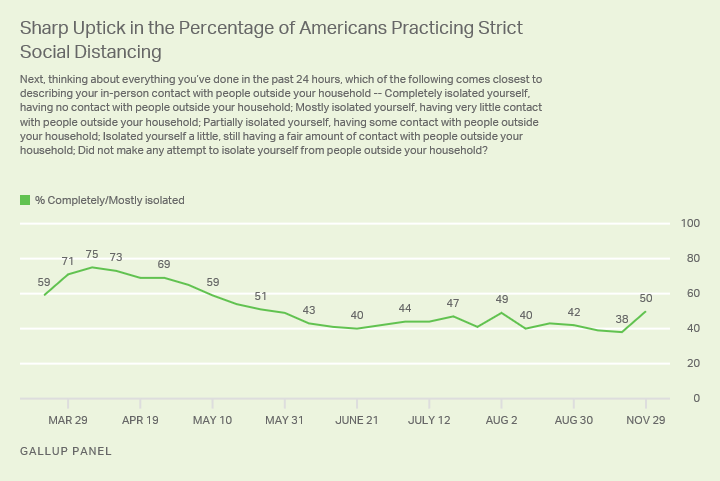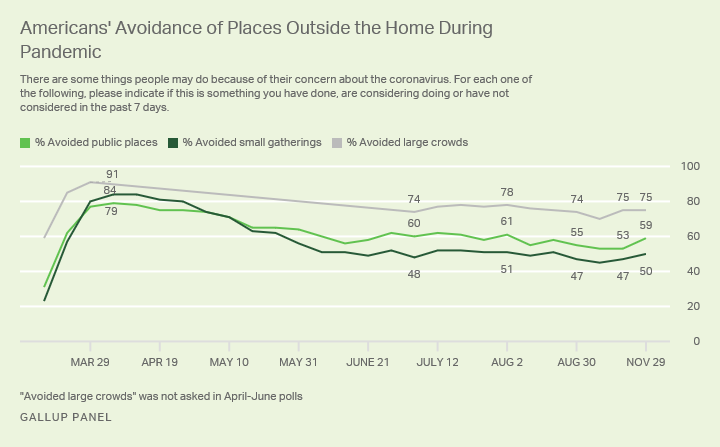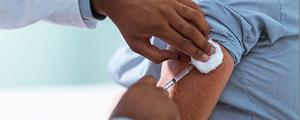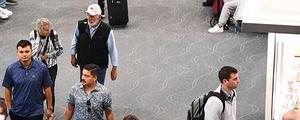Story Highlights
- 50% are completely or mostly isolating themselves from others
- Up from 38% last month
- Fewer report visiting restaurants, including dining in
WASHINGTON, D.C. -- As coronavirus cases continue to rise in the U.S., a growing percentage of Americans are practicing strict social distancing. Half of Americans now say they are completely (16%) or mostly (34%) isolating themselves from people outside their household. The combined 50% is up from 38% in the previous poll and the highest it has been since May.
Yet, the latest reading is well below the peak in social distancing that came in late March and early April -- three-quarters of Americans were completely or mostly isolating themselves when many states had issued stay-at-home orders.

Line graph. Half of Americans say they have completely or mostly isolated themselves from people outside their household in the past 24 hours, an increase from 38% last month. The percentage had been below 50% since May 24; with last month's 38% the low reading since then.
The latest figures are from a Nov. 16-29 web survey of more than 2,900 members of Gallup's probability-based panel. The poll also found the percentage of Americans saying the coronavirus situation in the U.S. is getting worse, and the percentage expressing concern about personally getting the virus, at highs.
Compared with the prior survey, conducted Oct. 19-Nov. 1, reports of stricter social isolation are higher among all key subgroups. The increases are proportionately larger among women, Democrats and Northeastern residents. Men and political independents show some of the smallest increases in social distancing.
Democrats (66%), college graduates (59%), and those who are not working (58%) are the groups most likely to say they are completely or mostly isolating themselves from others. Republicans (32%) continue to be least likely to say this.
| Oct 19-Nov 1 | Nov 16-29 | Change | |||||||||||||||||||||||||||||||||||||||||||||||||||||||||||||||||||||||||||||||||||||||||||||||||
|---|---|---|---|---|---|---|---|---|---|---|---|---|---|---|---|---|---|---|---|---|---|---|---|---|---|---|---|---|---|---|---|---|---|---|---|---|---|---|---|---|---|---|---|---|---|---|---|---|---|---|---|---|---|---|---|---|---|---|---|---|---|---|---|---|---|---|---|---|---|---|---|---|---|---|---|---|---|---|---|---|---|---|---|---|---|---|---|---|---|---|---|---|---|---|---|---|---|---|---|
| % | % | pct. pts. | |||||||||||||||||||||||||||||||||||||||||||||||||||||||||||||||||||||||||||||||||||||||||||||||||
| U.S. adults | 38 | 50 | +12 | ||||||||||||||||||||||||||||||||||||||||||||||||||||||||||||||||||||||||||||||||||||||||||||||||
| Men | 38 | 42 | +4 | ||||||||||||||||||||||||||||||||||||||||||||||||||||||||||||||||||||||||||||||||||||||||||||||||
| Women | 38 | 57 | +19 | ||||||||||||||||||||||||||||||||||||||||||||||||||||||||||||||||||||||||||||||||||||||||||||||||
| 18-44 years old | 40 | 52 | +12 | ||||||||||||||||||||||||||||||||||||||||||||||||||||||||||||||||||||||||||||||||||||||||||||||||
| 45-64 years old | 34 | 46 | +12 | ||||||||||||||||||||||||||||||||||||||||||||||||||||||||||||||||||||||||||||||||||||||||||||||||
| 65+ years old | 39 | 52 | +13 | ||||||||||||||||||||||||||||||||||||||||||||||||||||||||||||||||||||||||||||||||||||||||||||||||
| White adults | 37 | 49 | +12 | ||||||||||||||||||||||||||||||||||||||||||||||||||||||||||||||||||||||||||||||||||||||||||||||||
| Non-White adults | 39 | 50 | +11 | ||||||||||||||||||||||||||||||||||||||||||||||||||||||||||||||||||||||||||||||||||||||||||||||||
| Democrats | 48 | 66 | +18 | ||||||||||||||||||||||||||||||||||||||||||||||||||||||||||||||||||||||||||||||||||||||||||||||||
| Independents | 41 | 45 | +4 | ||||||||||||||||||||||||||||||||||||||||||||||||||||||||||||||||||||||||||||||||||||||||||||||||
| Republicans | 20 | 32 | +12 | ||||||||||||||||||||||||||||||||||||||||||||||||||||||||||||||||||||||||||||||||||||||||||||||||
| College graduates | 45 | 59 | +14 | ||||||||||||||||||||||||||||||||||||||||||||||||||||||||||||||||||||||||||||||||||||||||||||||||
| Not college graduates | 33 | 46 | +13 | ||||||||||||||||||||||||||||||||||||||||||||||||||||||||||||||||||||||||||||||||||||||||||||||||
| Employed | 33 | 44 | +11 | ||||||||||||||||||||||||||||||||||||||||||||||||||||||||||||||||||||||||||||||||||||||||||||||||
| Not employed | 44 | 58 | +14 | ||||||||||||||||||||||||||||||||||||||||||||||||||||||||||||||||||||||||||||||||||||||||||||||||
| Northeast | 34 | 51 | +17 | ||||||||||||||||||||||||||||||||||||||||||||||||||||||||||||||||||||||||||||||||||||||||||||||||
| Midwest | 37 | 46 | +9 | ||||||||||||||||||||||||||||||||||||||||||||||||||||||||||||||||||||||||||||||||||||||||||||||||
| South | 39 | 50 | +11 | ||||||||||||||||||||||||||||||||||||||||||||||||||||||||||||||||||||||||||||||||||||||||||||||||
| West | 40 | 53 | +13 | ||||||||||||||||||||||||||||||||||||||||||||||||||||||||||||||||||||||||||||||||||||||||||||||||
| Gallup Panel, 2020 | |||||||||||||||||||||||||||||||||||||||||||||||||||||||||||||||||||||||||||||||||||||||||||||||||||
Increased Majority Avoiding Public Places
At the same time that more Americans report greater social distancing, there has been a modest uptick in the percentage who say they have avoided going to public places, from 53% to 59%. While the percentage who are avoiding small gatherings, 50%, is up slightly from 47% in the late October survey, the change is not statistically meaningful. The survey's field period overlapped the Thanksgiving holiday, before which public health officials were urging Americans to keep their celebrations limited. While travel during the holiday week was well below last year, it was also the highest it had been since the pandemic began.
Three-quarters of Americans -- unchanged from last month -- continue to say they are avoiding large crowds.
All three behaviors are less common now than they were earlier in the pandemic, particularly during the initial surge in cases in March and April, but no more common than during the summer months.

Line graph. More Americans than in the prior survey are avoiding public places, but the percentage doing so remains lower than it was earlier in this year, including 79% in late March and early April. Fewer Americans today than in the spring are avoiding large crowds and small gatherings.
Restaurant Visits Down
Asked about specific places they have visited in the past 24 hours, 22% of U.S. adults said they visited a restaurant. This is down from 28% in the October survey. There was a similar decline in the percentage who reported dining in at a restaurant, dropping from 18% to 13% of U.S. adults. Many states have imposed restrictions on dining in at restaurants as a way to deal with the rise in COVID-19 cases.
The 18% who said they had dined in at a restaurant in the prior survey was the high point in the trend.

Line graph. Twenty-two percent of Americans said they visited a restaurant in the past 24 hours, down from 28% in late October. Thirteen percent said they dined in at a restaurant, down from 18%. Both figures are the lowest since late July, but still above what they were in May.
Reported visits to other public places have shown slight, but not statistically meaningful, declines, or have not changed in the past month.
| Oct 19-Nov 1 | Nov 16-29 | Change | |||||||||||||||||||||||||||||||||||||||||||||||||||||||||||||||||||||||||||||||||||||||||||||||||
|---|---|---|---|---|---|---|---|---|---|---|---|---|---|---|---|---|---|---|---|---|---|---|---|---|---|---|---|---|---|---|---|---|---|---|---|---|---|---|---|---|---|---|---|---|---|---|---|---|---|---|---|---|---|---|---|---|---|---|---|---|---|---|---|---|---|---|---|---|---|---|---|---|---|---|---|---|---|---|---|---|---|---|---|---|---|---|---|---|---|---|---|---|---|---|---|---|---|---|---|
| % | % | pct. pts. | |||||||||||||||||||||||||||||||||||||||||||||||||||||||||||||||||||||||||||||||||||||||||||||||||
| Restaurant | 28 | 22 | -6 | ||||||||||||||||||||||||||||||||||||||||||||||||||||||||||||||||||||||||||||||||||||||||||||||||
| Doctor's office, hospital or treatment center | 14 | 10 | -4 | ||||||||||||||||||||||||||||||||||||||||||||||||||||||||||||||||||||||||||||||||||||||||||||||||
| Salon or barbershop | 7 | 3 | -4 | ||||||||||||||||||||||||||||||||||||||||||||||||||||||||||||||||||||||||||||||||||||||||||||||||
| Grocery store | 53 | 50 | -3 | ||||||||||||||||||||||||||||||||||||||||||||||||||||||||||||||||||||||||||||||||||||||||||||||||
| Pharmacy | 19 | 16 | -3 | ||||||||||||||||||||||||||||||||||||||||||||||||||||||||||||||||||||||||||||||||||||||||||||||||
| Gym | 6 | 3 | -3 | ||||||||||||||||||||||||||||||||||||||||||||||||||||||||||||||||||||||||||||||||||||||||||||||||
| Your place of work | 37 | 35 | -2 | ||||||||||||||||||||||||||||||||||||||||||||||||||||||||||||||||||||||||||||||||||||||||||||||||
| Place of worship | 11 | 9 | -2 | ||||||||||||||||||||||||||||||||||||||||||||||||||||||||||||||||||||||||||||||||||||||||||||||||
| Someone else's home or apartment | 21 | 20 | -1 | ||||||||||||||||||||||||||||||||||||||||||||||||||||||||||||||||||||||||||||||||||||||||||||||||
| Other store | 26 | 26 | 0 | ||||||||||||||||||||||||||||||||||||||||||||||||||||||||||||||||||||||||||||||||||||||||||||||||
| Public transportation | 2 | 2 | 0 | ||||||||||||||||||||||||||||||||||||||||||||||||||||||||||||||||||||||||||||||||||||||||||||||||
| Travel | 2 | 3 | +1 | ||||||||||||||||||||||||||||||||||||||||||||||||||||||||||||||||||||||||||||||||||||||||||||||||
| Items sorted on basis of change since October | |||||||||||||||||||||||||||||||||||||||||||||||||||||||||||||||||||||||||||||||||||||||||||||||||||
| Gallup Panel, 2020 | |||||||||||||||||||||||||||||||||||||||||||||||||||||||||||||||||||||||||||||||||||||||||||||||||||
Grocery stores remain the place outside the home Americans are most likely to visit, followed by their place of work. About one in five report visiting someone else's home or apartment. The Thanksgiving holiday may account for the lack of a decline from October in visits to other people's homes, as well as in travel, with desire to see family and friends on Thanksgiving offsetting Americans' growing belief that the COVID-19 situation is getting worse and their greater concern about catching the virus.
Bottom Line
The rise in COVID-19 cases has caused more Americans than in late October to socially isolate themselves from others. However, the degree of social isolation is still far below what it was during the initial phases of the pandemic. This could partly be explained by there being fewer formal state lockdowns than was the case in the spring.
It may also be that Americans have greater knowledge about how they can protect themselves when they do go out, and are following the advice of infectious disease experts who have learned more about the disease and how to prevent its spread. The poll finds more than nine in 10 Americans (91%) continue to report they wear masks when outside the home.
Still, many public health officials believe small gatherings can contribute to the spread of the coronavirus. In these situations, people may be less inclined to take measures to protect themselves from getting the virus. With cases rising to never-before-seen levels after Thanksgiving, the Christmas holiday will further test Americans' ability to keep themselves safe and limit the spread of the virus.
Learn more about how the Gallup Panel works.




